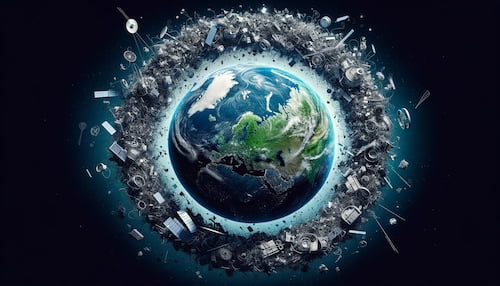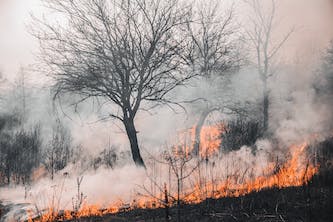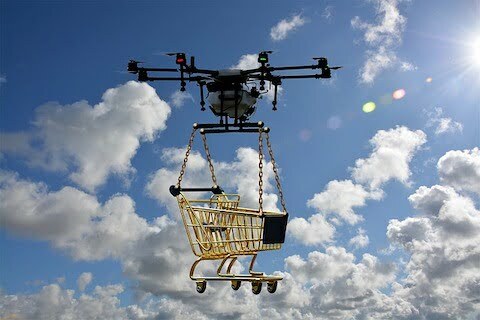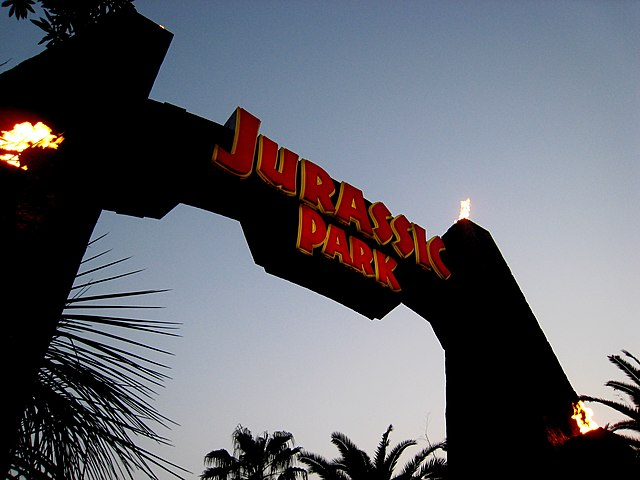The US government has issued its first-ever fine to a company for leaving space junk in orbit around the Earth. Dish Network has been fined $150,000 for failing to move an old satellite far enough away from others in use. The company admitted liability and agreed to a compliance plan with the Federal Communications Commission (FCC). Space junk, officially known as space debris, consists of old satellites and parts of spacecraft that are no longer in use and pose a risk of collisions. The FCC stated that Dish’s satellite posed a potential risk to other satellites at its current altitude.
Dish’s EchoStar-7 satellite, launched in 2002, was in geostationary orbit, starting at 22,000 miles above the Earth’s surface. Dish was supposed to move the satellite 186 miles further from Earth, but by 2022, it had only moved it 76 miles after losing fuel. The FCC’s enforcement bureau chief, Loyaan Egal, emphasized the importance of operators complying with their commitments as satellite operations become more prevalent and the space economy accelerates. The $150,000 fine represents a small portion of Dish’s overall revenue, but it may still have an impact on other satellite operators, signaling the FCC’s enforcement authority and capability.
Dr. Megan Argo, a senior lecturer in astrophysics at the University of Central Lancashire, believes that the FCC’s use of regulatory powers for the first time will make the rest of the industry take notice. The increasing number of objects in orbit increases the risk of collisions, leading to high-speed debris that can potentially cause a cascade reaction and damage other satellites. Over 10,000 satellites have been launched into space since 1957, with more than half of them now out of use. NASA estimates that there are over 25,000 pieces of space debris measuring over 10cm long.
NASA boss Bill Nelson has highlighted the seriousness of the space junk problem, stating that even a small paint chip traveling at orbital speed could be fatal to an astronaut during a spacewalk. The International Space Station has had to be moved to avoid debris flying past. The fine issued to Dish Network serves as a reminder to the industry about the importance of adhering to space debris rules and regulations.
Original news source: US issues first ever fine for space junk to Dish Network (BBC)
Listen
Slow
Normal
Fast
Group or Classroom Activities
Warm-up Activities:
– News Summary
Instructions: In pairs, students will read the article and then summarize the main points in their own words. They should focus on the key information and use concise language to communicate the main ideas. Afterward, students can share their summaries with the class and discuss any differences or similarities in their understanding of the article.
– Opinion Poll
Instructions: Students will form groups and discuss their opinions on the topic of space junk and the fine issued to Dish Network. They should consider the potential risks of space debris, the responsibility of satellite operators, and the role of government regulation. Each group will then present their opinions to the class, and a class-wide poll can be conducted to determine the majority viewpoint.
– Word Association
Instructions: The teacher will write the word “space junk” on the board. Students will then take turns saying words or phrases that they associate with this term. The associations can be related to the environmental impact, technological advancements, or any other aspect of space junk. This activity will help students expand their vocabulary and explore different perspectives on the topic.
– Sketch It
Instructions: In pairs, students will work together to create a visual representation of the concept of space junk. They can use drawings, symbols, or diagrams to depict the key ideas and challenges related to this topic. Afterward, each pair will present their sketch to the class and explain their artistic choices. This activity encourages creative thinking and visual communication skills.
– Future Predictions
Instructions: Students will individually write down their predictions for the future of space junk and its impact on space exploration. They should consider technological advancements, government regulations, and potential solutions to the problem. Afterward, students can share their predictions in small groups and engage in discussions about the feasibility of their ideas. This activity promotes critical thinking and encourages students to consider the long-term consequences of space debris.
Comprehension Questions:
1. What is space junk and why is it a concern?
2. Why was Dish Network fined by the US government?
3. How far was Dish Network supposed to move their old satellite from Earth?
4. Why did Dish Network fail to move their satellite the required distance?
5. What is the potential risk of space debris colliding with other satellites?
6. How many satellites have been launched into space since 1957?
7. Why is even a small paint chip a potential danger to astronauts during a spacewalk?
8. What is the significance of the fine issued to Dish Network for the rest of the industry?
Go to answers ⇩
Listen and Fill in the Gaps:
The US government has issued its first-ever fine to a company for (1)______ space junk in orbit around the Earth. Dish Network has been fined $150,000 for failing to move an old satellite far enough away from others in use. The company admitted liability and agreed to a compliance plan with the Federal (2)______ Commission (FCC). Space junk, officially known as space debris, consists of old (3)______ and parts of spacecraft that are no longer in use and pose a risk of (4)______. The FCC stated that Dish’s satellite posed a potential risk to other satellites at its current (5)______.
Dish’s EchoStar-7 satellite, launched in 2002, was in geostationary orbit, starting at 22,000 miles above the Earth’s surface. Dish was supposed to move the satellite 186 miles further from Earth, but by 2022, it had only moved it 76 miles after losing fuel. The FCC’s (6)______ bureau (7)______, (8)______ Egal, emphasized the importance of operators complying with their commitments as satellite operations become more prevalent and the space economy accelerates. The $150,000 fine represents a small portion of Dish’s overall revenue, but it may still have an impact on other satellite operators, signaling the FCC’s enforcement authority and capability.
Dr. Megan Argo, a (9)______ lecturer in astrophysics at the University of (10)______ Lancashire, believes that the FCC’s use of regulatory powers for the first time will make the rest of the industry take notice. The increasing number of objects in orbit increases the risk of collisions, leading to high-speed (11)______ that can potentially cause a (12)______ reaction and damage other satellites. Over 10,000 satellites have been launched into space since 1957, with more than half of them now out of use. NASA estimates that there are over 25,000 pieces of space debris measuring over 10cm long.
NASA boss Bill Nelson has highlighted the seriousness of the space junk problem, (13)______ that even a small paint chip traveling at orbital (14)______ could be fatal to an astronaut during a spacewalk. The International Space (15)______ has had to be moved to avoid debris flying past. The fine (16)______ to Dish Network serves as a reminder to the industry about the importance of adhering to space debris rules and regulations.
Go to answers ⇩
Discussion Questions:
Students can ask a partner these questions, or discuss them as a group.
1. What is space junk and why is it a problem?
2. How would you feel if you were an astronaut and had to worry about space junk during a spacewalk?
3. Do you think the $150,000 fine is enough to deter companies from leaving space junk in orbit? Why or why not?
4. What measures do you think should be taken to prevent the accumulation of space debris?
5. How do you think the increasing number of satellites in orbit affects the risk of collisions?
6. Do you think satellite operators should be held responsible for the space debris they create? Why or why not?
7. Have you ever heard of any other instances where companies or individuals were fined for space debris violations?
8. How do you think the space economy will be affected if the problem of space debris is not addressed?
9. What steps do you think should be taken to clean up existing space debris?
10. Do you think space agencies and satellite operators should prioritize the removal of space debris over launching new satellites?
11. How do you think the issue of space debris impacts international cooperation in space exploration?
12. Have you ever seen any documentaries or movies about space debris? If so, what did you learn from them?
13. What do you think is the biggest challenge in regulating and managing space debris?
14. How do you think advancements in technology can help mitigate the problem of space debris?
15. Do you think the general public is aware of the issue of space debris? Why or why not?
Individual Activities
Vocabulary Meanings:
Match each word to its meaning.
Words:
1. space junk
2. fine
3. satellite
4. compliance
5. risk
6. collisions
7. debris
8. regulations
Meanings:
(a) Possibility of harm or danger
(b) Fragments or remains of objects in space
(c) Old satellites and parts of spacecraft in orbit
(d) Object launched into space for various purposes
(e) Impact or clash between objects in space
(f) Penalty or punishment for a violation
(g) Rules and guidelines governing space activities
(h) Adherence to rules and guidelines
Go to answers ⇩
Multiple Choice Questions:
1. What has the US government issued its first-ever fine for?
(a) Launching too many satellites
(b) Leaving space junk in orbit
(c) Not complying with FCC regulations
(d) Damaging other satellites
2. What is space junk officially known as?
(a) Satellite waste
(b) Orbiting garbage
(c) Astronomical trash
(d) Space debris
3. How far was Dish Network’s satellite supposed to be moved from Earth?
(a) 76 miles
(b) 186 miles
(c) 22,000 miles
(d) 10cm
4. Why did Dish Network fail to move the satellite far enough?
(a) It lost fuel
(b) It didn’t have the technology
(c) It didn’t think it was necessary
(d) It didn’t have the funds
5. What does the FCC’s enforcement bureau chief emphasize?
(a) The need for more satellites in orbit
(b) The potential profits of the space economy
(c) The importance of compliance with commitments
(d) The danger of space debris to astronauts
6. How many satellites have been launched into space since 1957?
(a) Over 10,000
(b) Over 25,000
(c) Over 5,000
(d) Over 50,000
7. What risk does NASA boss Bill Nelson highlight?
(a) Damage to the International Space Station
(b) High-speed debris causing a cascade reaction
(c) Fatalities to astronauts during spacewalks
(d) Collisions between satellites
8. What is the purpose of the fine issued to Dish Network?
(a) To bankrupt Dish Network
(b) To fund NASA’s space debris research
(c) To remind the industry about space debris rules
(d) To set a precedent for future fines
Go to answers ⇩
True or False Questions:
1. Dish’s EchoStar-7 satellite was supposed to be moved 186 miles further from Earth, but by 2022, it had only been moved 76 miles.
2. NASA estimates that there are less than 25,000 pieces of space debris measuring over 10cm long.
3. The $150,000 fine represents a small portion of Dish’s overall revenue.
4. Dish Network has been awarded $150,000 for successfully moving an old satellite far enough away from others in use.
5. Space junk, officially known as space debris, consists of new satellites and intact parts of spacecraft that are still in use and do not pose a risk of collisions.
6. The US government has issued its first-ever fine to a company for leaving space junk in orbit around the Earth.
7. Dish denied liability and refused to comply with the Federal Communications Commission (FCC).
8. Dr. Megan Argo believes that the FCC’s use of regulatory powers for the first time will make the rest of the industry take notice.
Go to answers ⇩
Write a Summary:
Write a summary of this news article in two sentences.
Check your writing now with the best free AI for English writing!
Writing Questions:
Answer the following questions. Write as much as you can for each answer.
Check your answers with our free English writing assistant!
1. What is the fine that Dish Network has been issued by the US government?
2. What is space junk and why is it a problem?
3. Why was Dish Network fined for leaving its satellite in orbit?
4. How many satellites have been launched into space since 1957 and how many are now out of use?
5. Why is the issue of space junk important for the safety of astronauts and space missions?
Answers
Comprehension Question Answers:
1. What is space junk and why is it a concern?
Space junk, officially known as space debris, consists of old satellites and parts of spacecraft that are no longer in use. It is a concern because it poses a risk of collisions with active satellites and can create high-speed debris that can cause damage.
2. Why was Dish Network fined by the US government?
Dish Network was fined for failing to move an old satellite far enough away from others in use, which posed a potential risk to other satellites.
3. How far was Dish Network supposed to move their old satellite from Earth?
Dish Network was supposed to move their old satellite 186 miles further from Earth.
4. Why did Dish Network fail to move their satellite the required distance?
Dish Network failed to move their satellite the required distance because it had lost fuel.
5. What is the potential risk of space debris colliding with other satellites?
The potential risk of space debris colliding with other satellites is that it can cause damage and potentially create a cascade reaction, leading to more debris and more collisions.
6. How many satellites have been launched into space since 1957?
Over 10,000 satellites have been launched into space since 1957.
7. Why is even a small paint chip a potential danger to astronauts during a spacewalk?
Even a small paint chip can be a potential danger to astronauts during a spacewalk because it is traveling at orbital speed, and the impact can be fatal.
8. What is the significance of the fine issued to Dish Network for the rest of the industry?
The fine issued to Dish Network serves as a reminder to the industry about the importance of adhering to space debris rules and regulations. It shows that the US government is willing to enforce these rules and signals the FCC’s enforcement authority and capability.
Go back to questions ⇧
Listen and Fill in the Gaps Answers:
(1) leaving
(2) Communications
(3) satellites
(4) collisions
(5) altitude
(6) enforcement
(7) chief
(8) Loyaan
(9) senior
(10) Central
(11) debris
(12) cascade
(13) stating
(14) speed
(15) Station
(16) issued
Go back to questions ⇧
Vocabulary Meanings Answers:
1. space junk
Answer: (c) Old satellites and parts of spacecraft in orbit
2. fine
Answer: (f) Penalty or punishment for a violation
3. satellite
Answer: (d) Object launched into space for various purposes
4. compliance
Answer: (h) Adherence to rules and guidelines
5. risk
Answer: (a) Possibility of harm or danger
6. collisions
Answer: (e) Impact or clash between objects in space
7. debris
Answer: (b) Fragments or remains of objects in space
8. regulations
Answer: (g) Rules and guidelines governing space activities
Go back to questions ⇧
Multiple Choice Answers:
1. What has the US government issued its first-ever fine for?
Answer: (b) Leaving space junk in orbit
2. What is space junk officially known as?
Answer: (d) Space debris
3. How far was Dish Network’s satellite supposed to be moved from Earth?
Answer: (b) 186 miles
4. Why did Dish Network fail to move the satellite far enough?
Answer: (a) It lost fuel
5. What does the FCC’s enforcement bureau chief emphasize?
Answer: (c) The importance of compliance with commitments
6. How many satellites have been launched into space since 1957?
Answer: (a) Over 10,000
7. What risk does NASA boss Bill Nelson highlight?
Answer: (d) Collisions between satellites
8. What is the purpose of the fine issued to Dish Network?
Answer: (c) To remind the industry about space debris rules
Go back to questions ⇧
True or False Answers:
1. Dish’s EchoStar-7 satellite was supposed to be moved 186 miles further from Earth, but by 2022, it had only been moved 76 miles. (Answer: True)
2. NASA estimates that there are less than 25,000 pieces of space debris measuring over 10cm long. (Answer: False)
3. The $150,000 fine represents a small portion of Dish’s overall revenue. (Answer: True)
4. Dish Network has been awarded $150,000 for successfully moving an old satellite far enough away from others in use. (Answer: False)
5. Space junk, officially known as space debris, consists of new satellites and intact parts of spacecraft that are still in use and do not pose a risk of collisions. (Answer: False)
6. The US government has issued its first-ever fine to a company for leaving space junk in orbit around the Earth. (Answer: True)
7. Dish denied liability and refused to comply with the Federal Communications Commission (FCC). (Answer: False)
8. Dr. Megan Argo believes that the FCC’s use of regulatory powers for the first time will make the rest of the industry take notice. (Answer: True)
Go back to questions ⇧













